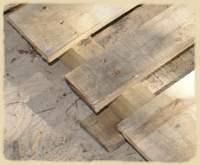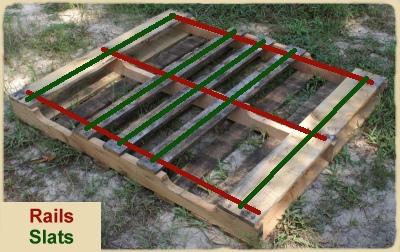Buy the Book
Subscribe to Updates
Who Are the Monkeys?
Inside the Book
Resources for Readers
Reviews
Bonus Tom Articles
Facebook Fan Page
Contact Us
Publisher

A Pallet Construction Primer, Page 2
Contents Introduction Pallet Basics Pallet Disassembly Pallet Construction Pallet Basics
| Pallets come in many shapes and sizes, and degrees of wear and utility. Before using pallets in our project, let's get more familiar with their characteristics. As it turns out, palletry is almost a science in itself! Be sure to read this entire article to avoid common hazards and to maximize the utility of each pallet. |
| Anatomy of a Pallet To the right we see a typical pallet. For clarity, this pallet has been flipped over onto its back. Throughout our discussion here, the strong longitudinal members, shown in red, are called rails. The flimsy lateral members, shown in green, are called slats. Other sources may call the rails posts or beams, or call slats stringers, etc. The top of a pallet (shown against the ground here), will contain slats at more or less regular intervals, while the bottom will consist of a slat at each end and one or more slats in the middle for rigidity. The example shown here has three medial slats on the bottom. In general, the end slats will be wider than the interior slats, but will have absorbed more rough handling and forklift hits. Materials The pallet in the picture above is made entirely of oak. Oak is tough, heavy and durable, but it splinters easily when working with it. Other materials may include pine, or poplar, or practically any kind of wood which happens to be inexpensive where the pallet was made. Some pine pallets will be made of sawmill rejects in which the rails are rough-hewn 2x4 stock, while the slats may be rough-hewn 1x4 or 1x3 stock. Other pine slats will be indistinguishable from dimensioned 1x4 or 1x3 lumber you might find for sale at the building supply. Poplar will be notable by its soft, fuzzy appearance, Poplar rails will also usually look like rough-hewn 2x4 stock, but the slats will normally be thinner than 1x4 or 1x3 by 25% to 50%. In general, regardless of materials, expect to see slat thickness ranging from about 1/4" to 1/2", with some thicker, but very few thinner. Also, the width of the slats will vary from about 2" to 6", again with the inner slats typically narrow, with the outer slats at the ends typically wider. Also, if the slats are of dissimilar thickness, the interior slats will be thin, while the edge slats will be thick. Pallets are assembled with nails of various widths and lengths. One thing that practically all pallet nails have in common is the use of spiral flutes along their length. This characteristic makes pallets durable for material handling, but practically impossible to pry apart without destroying the slats in the process. We've tried many ways to take down pallets without damaging the slats, but all produce miserable yield compared to our favorite, the chainsaw. More about that in a moment. |

|
| In the next section, learn about disassembling pallets to recover their materials. |
Shop our

Online Store
or

or
Get it on Kindle
